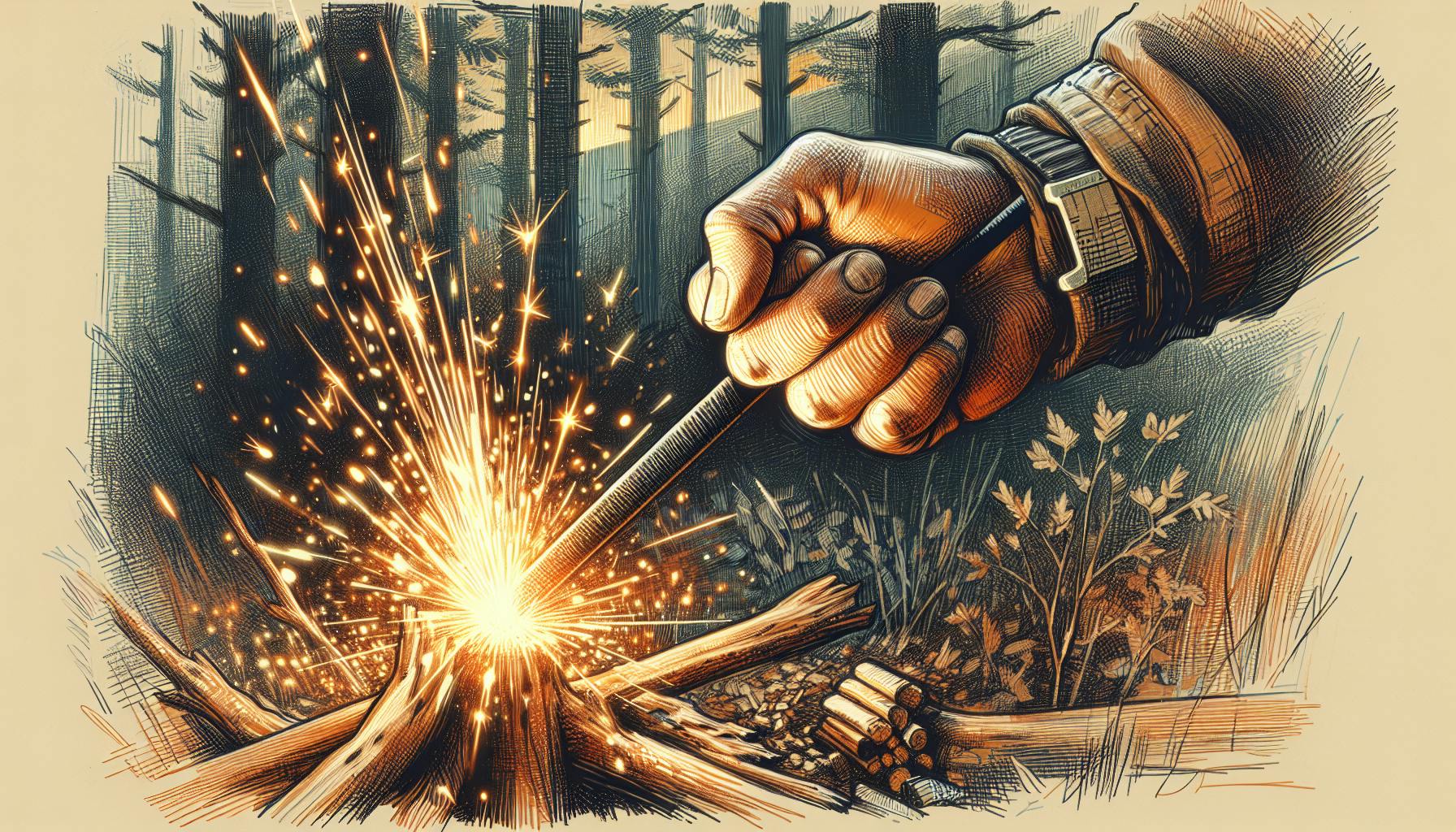When facing an emergency situation, having reliable communication tools can make all the difference.
Equipping yourself and your group with durable, long-range walkie talkies designed for survival provides vital connectivity when you need it most.
In this guide, we'll explore the essential features that make certain radios well-suited for outdoor survival and emergency preparedness. From battery life to weatherproofing, we'll cover what to look for so you can establish effective comms when conventional communication tools may not be available.
Introduction to Survival Walkie Talkies
A survival walkie talkie is a crucial communication tool for emergency preparedness. When cell networks are unavailable, these rugged two-way radios allow direct person-to-person communication over miles. Key features of a reliable survival walkie talkie include:
Defining Survival Walkie Talkies
Survival walkie talkies are designed to withstand tough outdoor conditions and keep working in emergencies when regular phones may fail. Key features include:
- Extended battery life - Can last weeks between charges to maintain communication.
- Weather resistance - Waterproof and shockproof casing to handle rain, dust, drops.
- Durable casing - Tough, thick plastic or metal prevents scratches and damage.
- Simple controls - Easy to use knobs and large buttons accessible with gloves on.
Having a radio that works despite the elements is crucial for situations like natural disasters or grid failure.
Why Survival Radios Are Vital for Emergency Comms
Unlike cell phones that rely on towers and infrastructure, survival radios enable direct walkie talkie-style communication up to several miles line-of-sight. This makes them extremely useful as emergency communication tools when normal networks are overloaded or unavailable.
Whether coordinating search parties, calling for help, or keeping families connected, having reliable short-range radios maintains vital communication channels. They provide a lifeline in the absence of traditional phone and internet access.
The Role of Walkie Talkies in Survival Gear
In a survival or disaster preparedness context, walkie talkies serve as a lifeline by:
- Enabling communication with others in your group or party.
- Allowing you to call for emergency help from rescuers or monitors emergency channels.
- Serving as a key piece of survival gear for coordinating resources & activities.
Having working walkie talkies and knowing emergency channel protocols can literally save lives in disasters by connecting people with critically needed assistance. They form the backbone of emergency communication.
What is the best radio for survival situation?
When choosing the best emergency radio for survival situations, key features to consider include:
Range and Reception
- A radio that can pick up AM, FM, and shortwave frequencies will provide the widest range of stations and emergency broadcasts.
- Look for a radio with multiple power sources like hand crank, solar panel, and battery so you can power and charge it in any situation.
Durability
- Choose a radio built to withstand drops, dust, water splashes, and temperature extremes. Rugged, impact-resistant casing is ideal.
- Prioritize radios with IPX water resistance ratings if possible.
Portability
- A compact, lightweight radio will be easiest to keep in your emergency kit or bug out bag.
- Consider one with a carry handle, strap, or carabiner for portability.
Battery Life
- Long battery life allows you to stay updated on news and weather for longer periods.
- Radios with rechargeable batteries you can continually replenish from hand crank or solar are most reliable.
The Midland ER310 checks all the key boxes with AM/FM/NOAA bands, multiple charging options, rugged casing, and smartphone charging. The RunningSnail Emergency Crank Radio is also a great portable and versatile option.
Would walkie-talkies work in an apocalypse?
Walkie talkies can be an essential part of an emergency preparedness kit and would likely still function during many disaster scenarios. Here are some key factors to consider regarding walkie talkie functionality in an apocalypse situation:
- Power Source: Walkie talkies rely on battery power, so having extra batteries or a way to recharge them would be critical. Crank or solar-powered walkie talkies could help mitigate this issue.
- Range: Basic walkie talkie range is typically 1-5 miles depending on terrain. For longer range communication, look for models with "FRS" (Family Radio Service) bands that can reach further distances.
- Durability: Most consumer walkie talkies are not ruggedized for extreme conditions. Look for waterproof, shockproof models rated for outdoor use if expecting rough treatment.
- Interference: During a large-scale disaster, there could be heavy reliance on radio communications clogging bandwidth. Stick to designated FRS channels and use coded privacy codes to connect only with your group.
- Backup Plan: Have a contingency for communication if walkie talkies become unusable or you get separated from your group. Designate physical meetup spots in case technology fails.
While not foolproof, walkie talkies are inexpensive, portable tools that could facilitate vital communication when other infrastructure fails. Just be sure to mitigate their limitations with preparedness ahead of time.
What is the best walkie-talkie for tactical people?
When choosing the best tactical walkie-talkie, key factors to consider are range, durability, battery life, and ease of use.
The Motorola TLK-100 and TLK-150 are top recommendations because they utilize a nationwide 4G LTE network to provide exceptional range across the United States. This allows wide-ranging tactical teams to maintain reliable communication.
Both models are designed for rugged use with an IP54 rating for dust and water resistance. They can withstand harsh environments, being dropped, and general wear and tear during tactical missions.
An integrated long-lasting battery provides up to 36 hours of operation on a single charge. This reduces the need to carry spare batteries or worry about the walkie-talkie dying during critical communications.
Despite advanced capabilities, the TLK models feature simple, intuitive controls for ease of use during high-stress situations. One-touch buttons allow quick access to functions like GPS location, messaging, and emergency alerts.
In summary, the Motorola TLK-100 and TLK-150 meet key criteria like extensive range, durability, battery life, and usability that define the best tactical walkie-talkies for teams needing resilient communication across broad operational areas.
sbb-itb-b932644
Can you use a walkie-talkie in an emergency?
Walkie-talkies can be extremely useful communication devices during emergencies for several reasons:
- Long Battery Life - Most walkie-talkies can operate for 12 hours or more on battery power alone, making them reliable when the electricity goes out. Models with rechargeable batteries allow you to reuse them.
- Durability - Walkie-talkies are built to withstand drops, shocks, dust, and moisture. This makes them ideal for harsh emergency conditions when other devices may fail.
- Extended Range - With a range of several miles, walkie-talkies allow emergency communications over decent distances. This facilitates coordination of response efforts.
- No Infrastructure Required - Walkie-talkies don't rely on cell towers or internet access. As long as two units are within range, communication is possible.
- Affordability - Quality emergency walkie-talkies are available at reasonable prices compared to more advanced radio equipment. Units can be purchased for personal, family, or group usage.
To use walkie-talkies effectively in an emergency:
- Conduct test runs to ensure familiarity with the device functions and range capabilities
- Establish agreed upon channel(s) and communication protocols beforehand
- Use headsets for hands-free operation and improved sound quality
- Have spare batteries and a way to recharge them
- Keep the units protected in a waterproof case or bag when not in use
With these best practices, two-way radios can provide reliable and resilient emergency communication. Their simplicity, durability, range, and independence from infrastructure make them well-suited for crisis scenarios.
Essential Features of Survival Walkie Talkies
Beyond baseline two-way radio capabilities, there are several specialized features that make a walkie talkie better suited for preppers and survivalists.
Walkie Talkies for Adults Long Range Communication
Look for adult-oriented walkie talkies that offer an extended transmission range, ensuring reliable communication over vast distances in various terrains.
- Choose a walkie talkie with a range of at least a few miles to maintain contact even when group members are separated. Models with a 20+ mile range are ideal.
- Select a radio that utilizes FRS (Family Radio Service) frequencies, which are less prone to interference over long distances.
- Consider a radio with NOAA weather band access for receiving emergency alerts while off-grid.
- Test the range capability by doing walkie talkie range tests before an outing. This verifies it works as expected in your region's terrain.
By opting for an extended-range walkie talkie made for outdoor use by adults, you enable reliable communication between group members in a survival situation. This keeps everyone coordinated even when beyond shouting distance.
Durability and Weatherproofing
A survival radio must be able to withstand rough conditions. This includes having a rugged, waterproof body that can endure extreme weather and rough handling.
- Seek out MIL-STD-810 certified radios that pass rigorous durability testing for shock, vibration, temperature extremes, and water submersion.
- Rubberized outer shells add impact absorption and grip. Internal metal frames also boost resilience.
- Waterproof walkie talkies rated at IPX7 or IPX8 can be submerged 1+ meter and keep working.
- Durable radios ensure continuous operation even if dropped, rained on, or exposed to dirt during an emergency.
Choosing an ultra-rugged walkie talkie model vastly improves reliability in unpredictable survival scenarios. The radio continues enabling communication despite inevitable rough treatment.
Battery Life and Power Options
Assessing the battery life is crucial for survival situations. The best survival walkie talkies offer long-lasting power and multiple charging options, including solar and hand-crank.
- Seek battery life of at least 24 hours for lengthy operations between charges.
- Solar panels and hand cranks allow charging the radio batteries indefinitely without grid power.
- Some models have rechargeable Li-ion battery packs, while others use standard replaceable AA batteries. Both offer pros and cons.
- Battery level indicators prevent unexpected failure by showing remaining runtime.
Carefully weigh power and charging considerations when selecting a survival radio. Having renewable charging and enough battery capacity could determine whether communications remain online during an extended off-grid emergency.
Communicating Effectively with Survival Walkie Talkies
For coordinating with your team in an emergency, your radio needs communication-focused features like channel scanning, hands-free use, and voice activation.
Channel Management for Coordinated Efforts
Effective use of multiple channels is key for organizing groups and maintaining clear lines of communication during emergencies.
- Having at least 16 channels allows you to separate communication by function, location, or group. For example, you could dedicate channels for security, medical response, supply runners, etc.
- Scanning capabilities let you monitor multiple channels so no call for help goes unheard. Priority channel scan is useful for keeping one channel at the fore while still scanning others.
- Narrowband channels take up less frequency space, allowing for more channel options without interference.
With strategic channel allocation and scanning, your survival walkie talkie keeps your community coordinated.
Hands-Free Communication with Headset Jacks
Headset support is essential for hands-free operation, allowing users to communicate while performing other survival tasks.
- Headset jacks let you plug in a microphone/earpiece for convenient hands-free use. Look for 2.5mm, 3.5mm or Bluetooth options.
- VOX (voice-operated transmit) is an alternative hands-free feature that senses voice vibrations and automatically transmits when you speak.
- With your hands free, you can continue working on security patrol, foraging for food, administering first aid, etc. while seamlessly maintaining communication.
Choose a survival radio with robust headset options for optimal hands-free utility.
Voice-Operated Transmit for Immediate Response
VOX, or voice-operated transmit, is a feature that allows for seamless, hands-free communication, which can be critical in fast-paced or dangerous situations.
- VOX automatically switches to transmit mode when the radio detects your voice, for quick, hands-free conversations.
- Adjustable sensitivity prevents unwanted background noises from triggering transmission.
- Rapid, convenient voice activation facilitates urgent communication when you need your hands for other tasks.
Look for VOX and headset jacks when selecting the best walkie talkies for your survival needs. The ability to respond hands-free could save precious seconds in an emergency.
Advanced Capabilities in Survival Walkie Talkies
Consider extra features like tone alerts, encryption, and weather radio bands to augment your emergency handheld radio. These additional capabilities can enhance a survival walkie talkie's effectiveness when every second counts.
Staying Informed with Emergency Weather Bands
Access to NOAA weather channels provides up-to-date information during extreme weather events. This can help you and your group make informed decisions to maximize safety. Key details like storm movement, intensity changes, and weather warnings are invaluable when exploring remote areas or bugging out. Select survival radios with weather band reception to stay informed.
Selective Call and Tone Alerts for Efficient Comms
Customizable call tones on a walkie talkie allow focused communications between your party members. Set unique tones for individual members or groups so you only need to listen for relevant calls. This prevents distraction from unwanted chatter while maintaining contact. Tone alerts also signal incoming transmissions, useful in noisy environments.
Securing Communications with Scramblers and Encryption
For discreet comms, encryption scrambles speech to prevent eavesdropping. This maintains operational security in a crisis scenario where outside forces may try intervening. Similarly, continuous tone-coded squelch system (CTCSS) uses sub-audible tones for selective calling between radios. Both features enhance a survival gear radio's capabilities for group coordination.
Conclusion: Equipping Yourself with the Right Survival Walkie Talkie
A reliable survival walkie talkie is essential preparation gear for preppers, adventurers, and first responders. When choosing a two-way radio for emergencies, key capabilities to prioritize include:
- Battery Life - Long battery life allows for extended use during power outages or off-grid activities. Look for walkie talkies with at least 8-12 hours of battery life. Consider removable, rechargeable battery packs for flexibility.
- Range - The range indicates how far apart you can communicate. Most consumer walkie talkies have a 0.5-2 mile range. For wide area coverage, look for 5+ mile range models or explore base station/repeater options to boost range.
- Ruggedness - Your radio needs resilience against drops, dust, water, etc. Seek IPX4 water resistance or higher and MIL-STD 810 ratings for durability. Rubberized casing adds protection.
- Emergency Features - Priority scan, emergency alarm and weather scan allow rapid response in crises. NOAA weather radio integration aids storm tracking.
Investing in survival radios designed for reliability, extended battery life, range, and rugged use ensures you stay connected with your team when it matters most - whether facing a natural disaster, grid failure, or outdoor excursion. Choosing the right tactical two-way radio equips you with a resilient lifeline for emergency preparedness.


